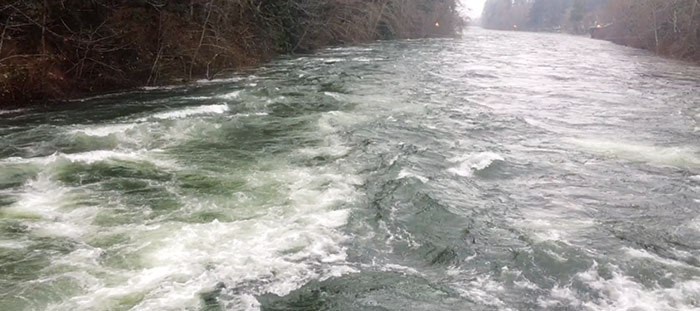Neil Cameron
Special to the Mirror
One of the largest returns of chinook salmon in a decade to the Campbell and Quinsam River systems has been put in peril by flooding water.
And, but for Mother Nature’s beneficial touch and the Quinsam River Hatchery, 2016’s water events could have proved even more disastrous.
“I’m very concerned about the Campbell,” Quinsam River manager Laurent Frisson said Monday. “The flows are still a little bit high to get a good feel, to figure out what happened. But I’m very concerned. As far as the Quinsam, I’m concerned as well, but not as much as the Campbell.”
The returns are difficult to calculate, said Frisson, but initial statistics indicated a “fantastic” run of chinook.
“It’s a little bit early to get the final return but just what we handled at the hatchery was 4,500,” said Frisson. “Double that is a very conservative potential.”
So a possible return of 9,000 to 10,000 chinook compares significantly to previous years. In 2015 there was a total of 3,800 chinooks, 2014 – 2,700, 2013 – 4,400, 2012 – 4,900, 2011 – 4,700, 2010 – 4,300 and 2009 – 7,100.
And while BC Hydro continued to spill water in historic amounts down the Campbell, the Quinsam raged as well. Hatchery staff members were forced to abandon their in-river brood stock fence — situated on the Quinsam River at the end of the Elk Falls provincial camp site — after only a few sets. At the fence, hatchery staff net the pool and take out prime brood stock candidates. Usually, that accounts for 80 per cent of the brood stock program. They abandoned the process with a fraction of what the hatchery needed.
Meanwhile, upstream, the surging Quinsam forced the opening of the counting gate. The counting gate directs fish into a run that leads to the hatchery. But its effectiveness is diminished when other parts of the gate are open. And that’s what the high water forced the hatchery to do, open some of the other gates to prevent a build up of water and debris that could cause damage to the infrastructure.
Amazingly, amid the brown, turbid water, the chinook found the sweet scent of Cold Creek, the water system upon which the hatchery is dependent. By the hundreds they found the small opening in the fence that leads to the hatchery, and went up.
“For a while there, we had 300 chinook a day come into the hatchery, day in and day out,” said Frisson. “If this manager had his crystal ball working really, really well he would have been a hero and told his crew not to worry about the fence, didn’t have to install it and didn’t have to worry about it. But there was no way of knowing.”
But for the Campbell it’s a different story. While spectators came in thousands to watch BC Hydro spill water from their system over Elk Falls, those same marvelous walls of water picked up and dispersed vital spawning gravels in the river. And with it spawning salmon and their eggs for future generations.
Only days before BC Hydro started their spills, dozens of chinook were seen spawning on the ‘Helicopter Run’, that section of the river adjacent to the helicopter landing pad near the John Hart Generating Station. Earlier this year the Campbell River Salmon Foundation spent thousands of dollars putting new spawning gravel into the run. Fears are the gravel has once again been swept away as it has been in previous years.
Frisson said he doubted the new gravel held and that it would take a big chinook digging really deep to avoid disaster. But he was still cautious in his estimations.
“The dominant year for chinooks spawning is in four-year cycles, so in four years we shouldn’t be surprised,” he said. “Until then you’re always going to have an argument because you’re jumping to conclusions. Let’s be realistic, we have a pretty good idea what happened and what’s happening. I think that it will show in two or four years that it could be problematic.”
In 2014, over one million pink salmon returned to the Campbell and Quinsam system. A deluge of rain and floods, smaller than what happened in 2016, hit the river systems. The pink salmon has a two year cycle, meaning that the progeny of that one million return should have came to the rivers this year. An average return would be about two to four per cent. Or about 200,000 and more.
Yet only about 60,000 made it back to the system in 2016.
So about the chinooks.
“The proof is in the pudding, that remains to be seen,” said Frisson. “But I think it’s safe to say that in four years, we are going to see an overwhelming number of hatchery fish, versus natural fish. In two years we also will because of the 2014 flood.”
Just after the hatchery began operations in 1974, it was credited with saving the original chinook genes of the Campbell chinook when it was found leachate from Westmin mines was killing and deforming young salmon.
Did the hatchery, and Mother Nature, come to the rescue again?
“In two and four years we shouldn’t be surprised,” said Frisson. “We know what went on, and it really doesn’t look good, but we won’t know what really happened until then.”
